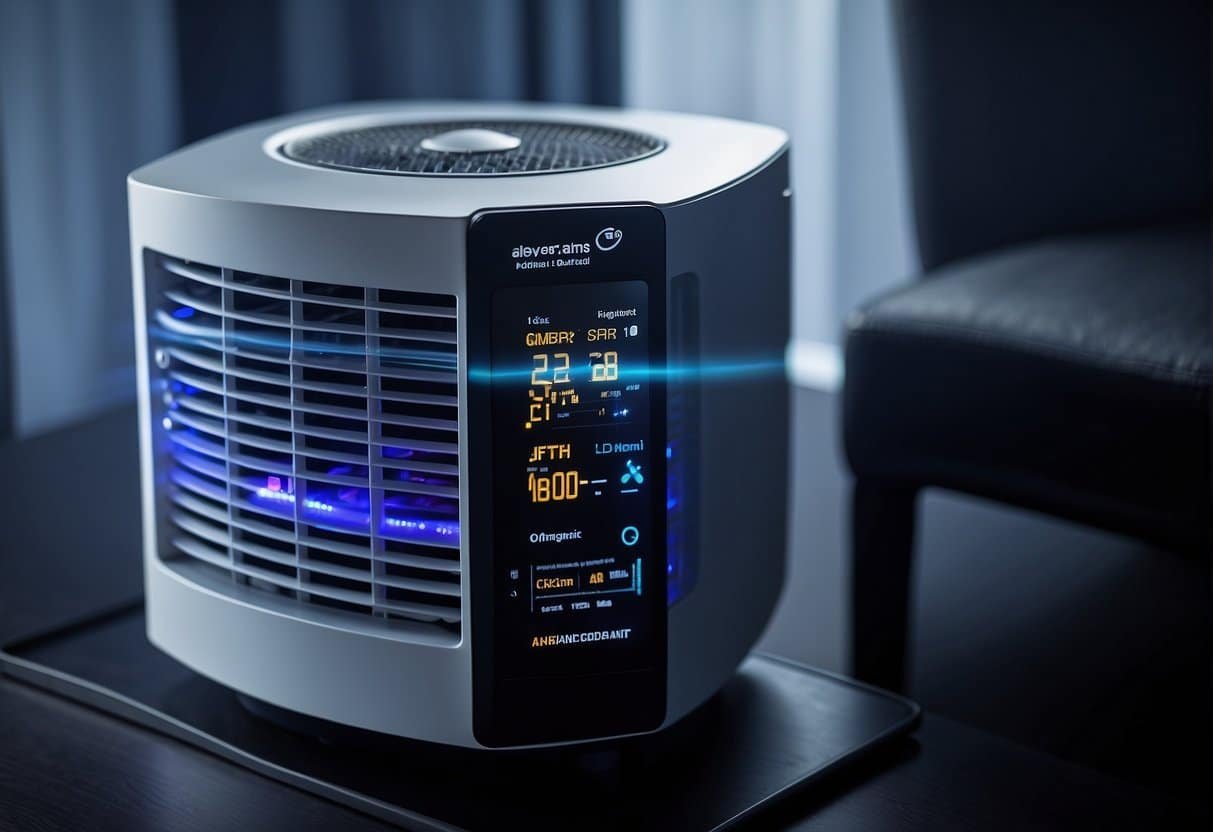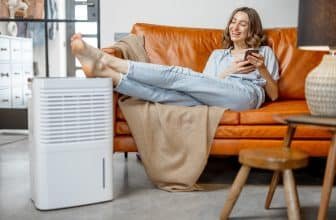Combination of UV Air Purifiers with Other Filter Technologies: Comprehensive Air Purification
UV air purifiers have become increasingly popular in recent years as more people become aware of the importance of clean air for their health. These devices use ultraviolet light to kill bacteria, viruses, and other microorganisms that can cause illness. However, UV air purifiers are not the only type of air purifier on the market. There are many different types of air filters available, each with its own strengths and weaknesses.

Combining UV air purifiers with other filter technologies can provide more comprehensive air purification. For example, some air purifiers use a combination of UV light and HEPA filters to remove particles from the air. HEPA filters are highly effective at capturing small particles like pet dander, pollen, and dust mites, while UV light can kill bacteria and viruses. Together, they provide a more thorough cleaning of the air in your home or office.
Combination of UV Air Purifiers with Other Filter Technologies – Comprehensive Air Purification: Key Takeaways
- Combining UV air purifiers with other filter technologies can provide more comprehensive air purification.
- HEPA filters are highly effective at capturing small particles like pet dander, pollen, and dust mites.
- UV light can kill bacteria and viruses.
Fundamentals of UV Air Purification
UV air purifiers are devices that use ultraviolet (UV) light technology to capture air and pass it through a filter. The air then goes through a small internal chamber where it becomes exposed to UV-C light, which can inactivate airborne pathogens and microorganisms like mold, bacteria, and viruses. UV-C light has a wavelength of 200 to 280 nanometers and is the most effective type of UV light for air purification.
Principles of UV Light and Air Purification
UV light is a type of electromagnetic radiation that has a shorter wavelength than visible light. It is divided into three categories based on its wavelength: UV-A (315 to 400 nm), UV-B (280 to 315 nm), and UV-C (200 to 280 nm). UV-C light is the most effective at killing microorganisms because it has the shortest wavelength and the most energy.
When UV-C light is applied to microorganisms, it damages their DNA or RNA, which prevents them from reproducing and growing. This process is called photodamage. UV-C light can also break down volatile organic compounds (VOCs) and other chemicals in the air.
Types of UV Light: UV-A, UV-B, and UV-C
UV-A light has the longest wavelength of the three types of UV light and is the least harmful to humans. It is commonly used in black lights and tanning beds.
UV-B light has a shorter wavelength than UV-A light and can cause sunburn and skin cancer in humans. It is also responsible for the production of vitamin D in the skin.
UV-C light has the shortest wavelength of the three types of UV light and is the most harmful to humans. It can cause skin and eye damage and is used in germicidal lamps and air purifiers.
In conclusion, UV air purifiers are effective at removing microorganisms and other pollutants from the air. When combined with other filter technologies, such as HEPA filters, they can provide more comprehensive air purification.
Combination of UV Air Purifiers and HEPA Filters
Advantages of Combined UV and HEPA Filtration
UV air purifiers and HEPA filters are two of the most popular types of air filtration systems available in the market. While both are effective in removing airborne contaminants and allergens, they work in different ways. UV air purifiers use ultraviolet light to kill bacteria and viruses, while HEPA filters trap particles as small as 0.3 microns.
When used together, UV air purifiers and HEPA filters can provide more comprehensive air purification. The combination of UV and HEPA filtration can effectively remove airborne contaminants, allergens, and smaller particles that may escape HEPA filters alone. This is because UV air purifiers can kill bacteria and viruses that may be too small to be trapped by HEPA filters.
Moreover, HEPA filters can capture larger particles that may shield smaller particles from UV light. This means that when used together, UV air purifiers and HEPA filters can provide more complete air purification.
Mechanism of HEPA Filters in Air Purification
HEPA filters are an essential component of air purifiers. They are designed to trap airborne particles as small as 0.3 microns, including dust, pollen, and other allergens. HEPA filters work by using a dense layer of fibers to capture airborne particles as they pass through the filter.
HEPA filters are highly effective in removing airborne contaminants, but they do have limitations. They cannot remove gases, odors, or volatile organic compounds (VOCs). This is where UV air purifiers come in. UV air purifiers can effectively remove bacteria, viruses, and other microorganisms that may be present in the air.
In conclusion, combining UV air purifiers with HEPA filters can provide more comprehensive air purification. HEPA filters can trap larger particles, while UV air purifiers can kill bacteria and viruses that may be too small to be trapped by HEPA filters alone. This combination can effectively remove airborne contaminants, allergens, and smaller particles, providing cleaner and healthier air.
Additional Filtration Technologies

Activated Carbon Filters and Their Role
Activated carbon filters are a popular type of filter used in air purification. They are made from activated carbon, which is a form of carbon that has been treated with oxygen to create a porous surface area. This porous surface area allows the activated carbon to trap and remove impurities from the air, such as volatile organic compounds (VOCs), odors, and gases.
When combined with UV air purifiers, activated carbon filters can provide more comprehensive air purification. While UV air purifiers are effective at killing bacteria, viruses, and other microorganisms, they do not remove larger particles or gases from the air. Activated carbon filters can help to remove these larger particles and gases, providing a more complete air purification system.
Other Filter Types: Pre-Filters, PCO, and Ionizers
In addition to activated carbon filters, there are other filter types that can be used in combination with UV air purifiers to provide more comprehensive air purification. Pre-filters, for example, are designed to trap larger particles, such as dust and pet dander, before they can reach the UV air purifier. This helps to prolong the life of the UV air purifier and ensures that it can focus on removing smaller particles and microorganisms from the air.
PCO (photocatalytic oxidation) technology is another type of filter that can be used in combination with UV air purifiers. PCO filters use UV light to activate a catalyst, which then reacts with impurities in the air to break them down into harmless substances. This technology is particularly effective at removing VOCs and other gases from the air.
Negative ionizers are another type of filter that can be used in combination with UV air purifiers. These filters release negatively charged ions into the air, which then attach themselves to positively charged particles, such as dust and pollen. This causes the particles to become too heavy to remain airborne, causing them to fall to the ground where they can be easily vacuumed or swept up.
Overall, by combining UV air purifiers with other filter types such as activated carbon filters, pre-filters, PCO technology, and negative ionizers, homeowners can achieve more comprehensive air purification, removing both smaller particles and microorganisms as well as larger particles and gases.
Impact on Air Quality and Health
UV air purifiers in combination with other filter types provide more comprehensive air purification. They are effective in reducing airborne pathogens and allergens and have benefits for asthma and allergy sufferers. However, there are also potential risks associated with the use of UV air purifiers.
Reduction of Airborne Pathogens and Allergens
UV air purifiers can effectively reduce airborne pathogens, such as bacteria and viruses, as well as allergens like mold spores and pollen. According to a systematic review from Medical News Today, UV air purifiers that use a HEPA filter may be effective at removing bacteria from the air. HEPA filters can capture particles as small as 0.3 microns, which includes most airborne pathogens and allergens. Combining UV air purifiers with HEPA filters can provide a more comprehensive air purification solution.
Benefits for Asthma and Allergy Sufferers
UV air purifiers can also have benefits for asthma and allergy sufferers. Allergens and pollutants in the air can trigger asthma and allergy symptoms, such as coughing, wheezing, and sneezing. UV air purifiers can help reduce the levels of these triggers in the air, which can lead to a reduction in symptoms. According to The Healthy, air purifiers have become increasingly popular due to the increase in health awareness caused by the Covid-19 pandemic.
Potential Risks: Ozone and By-products
While UV air purifiers can be effective in reducing airborne pathogens and allergens, there are also potential risks associated with their use. Some UV air purifiers can produce ozone and other by-products that can be harmful to human health. A good and safe UV air purifier should have a quality UVC lamp that does not make ozone or other by-products. It is important to research the specific UV air purifier before purchasing to ensure it is safe and effective.
In conclusion, UV air purifiers in combination with other filter types can provide more comprehensive air purification. They can effectively reduce airborne pathogens and allergens and have benefits for asthma and allergy sufferers. However, it is important to be aware of potential risks associated with their use, such as the production of ozone and other harmful by-products.
Considerations for Home and Office Environments
When it comes to air purification, combining UV air purifiers with other filter types can provide more comprehensive air purification. However, choosing the right combination for your space is crucial.
Choosing the Right Combination for Your Space
Home or office environments have different ventilation systems and airflow needs, and it is important to choose a combination of filters that suits your specific needs. For example, if you have an HVAC system in your office, you may want to consider a combination of UV air purifiers and HEPA filters to remove both particulate matter and microorganisms from the air.
Investment is also a consideration when choosing a combination of filters. While UV air purifiers may be more expensive than other filter types, they can be more effective at killing microorganisms. It is important to weigh the benefits of each filter type against the investment required.
Maintenance and Longevity of Combined Systems
Maintenance requirements and longevity are also important considerations when choosing a combination of filters. UV air purifiers require regular bulb replacement to maintain their effectiveness, while other filter types may require more frequent filter replacements.
Homeowners and office managers should also consider the maintenance requirements and longevity of their ventilation systems. Regular maintenance of ventilation systems can improve their efficiency and extend their lifespan, ultimately saving money in the long run.
In summary, combining UV air purifiers with other filter types can provide more comprehensive air purification. Choosing the right combination for your space and considering maintenance and longevity requirements are important factors to ensure effective air purification.
Cost and Efficiency Analysis

Evaluating the Cost-Benefit of Combined Purification Systems
Combining UV air purifiers with other filter technologies can provide more comprehensive air purification, but it also comes at a cost. The price of such systems can be higher than that of single-technology air purifiers. However, the investment in multi-technology purifiers can be cost-effective in the long run, especially in areas with high levels of pollution or for people with respiratory problems.
A cost-benefit analysis can help evaluate the effectiveness of combined purification systems. This analysis should consider the initial cost of the purifier, the cost of replacement filters, and the energy consumption of the purifier. The Environmental Protection Agency (EPA) recommends selecting a purifier with a high CADR (clean air delivery rate) and an Energy Star certification to ensure the purifier is efficient and cost-effective.
Energy Use and Efficiency of Multi-technology Purifiers
The energy consumption of multi-technology purifiers can vary depending on the type of filters and the size of the purifier. However, combining UV air purifiers with HEPA filters can be energy-efficient. UV air purifiers can kill airborne pathogens, while HEPA filters can trap larger particles. This combination can reduce the workload of the HEPA filter, which means less energy is required to circulate the air.
It is important to note that UV air purifiers should not be used as a standalone solution. They should be used in combination with other filter technologies to provide comprehensive air purification. In addition, UV air purifiers require regular maintenance, including cleaning the lamps and replacing the bulbs.
Overall, combining UV air purifiers with other filter technologies can provide more comprehensive air purification. Although the initial cost may be higher, it can be cost-effective in the long run. It is important to select a purifier with a high CADR and an Energy Star certification to ensure efficiency and cost-effectiveness.
Safety and Regulatory Considerations

UV-C Safety and Exposure Limits
UV-C lamps used in air purifiers can pose a risk of skin cancer and other health hazards if not used properly. It is important to follow the manufacturer’s instructions and never look directly at the UV-C lamp. Exposure to UV-C radiation can cause skin and eye irritation, and prolonged exposure can lead to skin cancer.
The American Conference of Governmental Industrial Hygienists (ACGIH) recommends a threshold limit value (TLV) of 6 milliwatts per square centimeter (mW/cm²) for continuous exposure to UV-C radiation. The TLV is the maximum radiation level that a person can be exposed to without experiencing harmful effects.
UV-C lamps should be shielded to prevent direct exposure to the eyes and skin. It is recommended to use air purifiers with UV-C lamps in combination with other filter technologies such as HEPA filters to provide comprehensive air purification while minimizing the risk of UV-C exposure.
Regulations and Standards for Air Purification Devices
The Environmental Protection Agency (EPA) regulates air purification devices under the Federal Insecticide, Fungicide, and Rodenticide Act (FIFRA). Air purifiers that make claims about killing or removing viruses, bacteria, or other pollutants are considered pesticide devices and must be registered with the EPA.
The EPA has established performance standards for air purification devices, including requirements for ozone emissions and electrical safety. Air purifiers that use UV-C lamps must comply with these standards to ensure they are safe and effective.
Manufacturers of air purifiers are also required to comply with industry standards such as those set by the American National Standards Institute (ANSI) and the International Electrotechnical Commission (IEC). These standards ensure that air purifiers are safe and effective for consumer use.
In summary, UV-C air purifiers can be effective at removing airborne pollutants but must be used with caution to avoid exposure to UV-C radiation. It is important to follow manufacturer instructions and use air purifiers that comply with EPA and industry standards to ensure safety and effectiveness.
Frequently Asked Questions
What are the benefits of combining UV light with HEPA filtration in air purifiers?
Combining UV light with HEPA filtration in air purifiers can provide more comprehensive air purification. HEPA filters are effective at capturing large particles, such as dust, pet dander, and pollen. However, they are less effective at capturing smaller particles, such as bacteria and viruses. UV light, on the other hand, can destroy these smaller particles. Therefore, combining UV light with HEPA filtration can provide a more thorough cleaning of the air.
How does UV-C technology in air purifiers enhance overall air quality?
UV-C technology in air purifiers can enhance overall air quality by destroying bacteria, viruses, and other microorganisms that may be present in the air. UV-C light has been shown to be effective at killing a variety of microorganisms, including those that cause colds, flu, and other respiratory illnesses.
What safety concerns should be considered when using air purifiers with UV light?
When using air purifiers with UV light, it is important to consider the potential for UV exposure. UV light can be harmful to humans and can cause skin and eye damage. Therefore, it is important to follow the manufacturer’s instructions when using these devices and to avoid direct exposure to the UV light.
Do air purifiers with UV light produce ozone, and if so, what are the implications?
Some air purifiers with UV light may produce ozone as a byproduct of the UV-C process. Ozone can be harmful to humans and can cause respiratory problems, especially in people with asthma or other respiratory conditions. Therefore, it is important to choose an air purifier that does not produce ozone or to use one that produces only a small amount.
In what situations is it most beneficial to use a UV air purifier with an ionizer?
UV air purifiers with ionizers can be beneficial in situations where there is a high concentration of airborne particles, such as in homes with pets or in areas with high levels of pollution. The ionizer can help to remove these particles from the air, while the UV light can destroy any microorganisms that may be present.
What is the effectiveness of whole house air purifiers with UV technology compared to portable units?
Whole house air purifiers with UV technology can be more effective than portable units because they can purify the air throughout the entire home. Portable units, on the other hand, are only effective in the room where they are located. However, whole house air purifiers can be more expensive and may require professional installation.
best air purifiers
My name is Philipp Walz, editor at best-air-purifiers.com, and I’m truly passionate about creating healthier living spaces through smart, effective air purification. For me, air purifiers aren’t just appliances – they’re a quiet revolution in how we breathe, live, and feel at home. Clean air means better sleep, clearer thinking, and fewer allergies. It’s about giving our bodies what they need most: pure, fresh air. I’ve experienced firsthand how the right air purifier can transform a space and improve well-being – and I’m here to help others discover that difference. Because when you breathe better, you live better.






